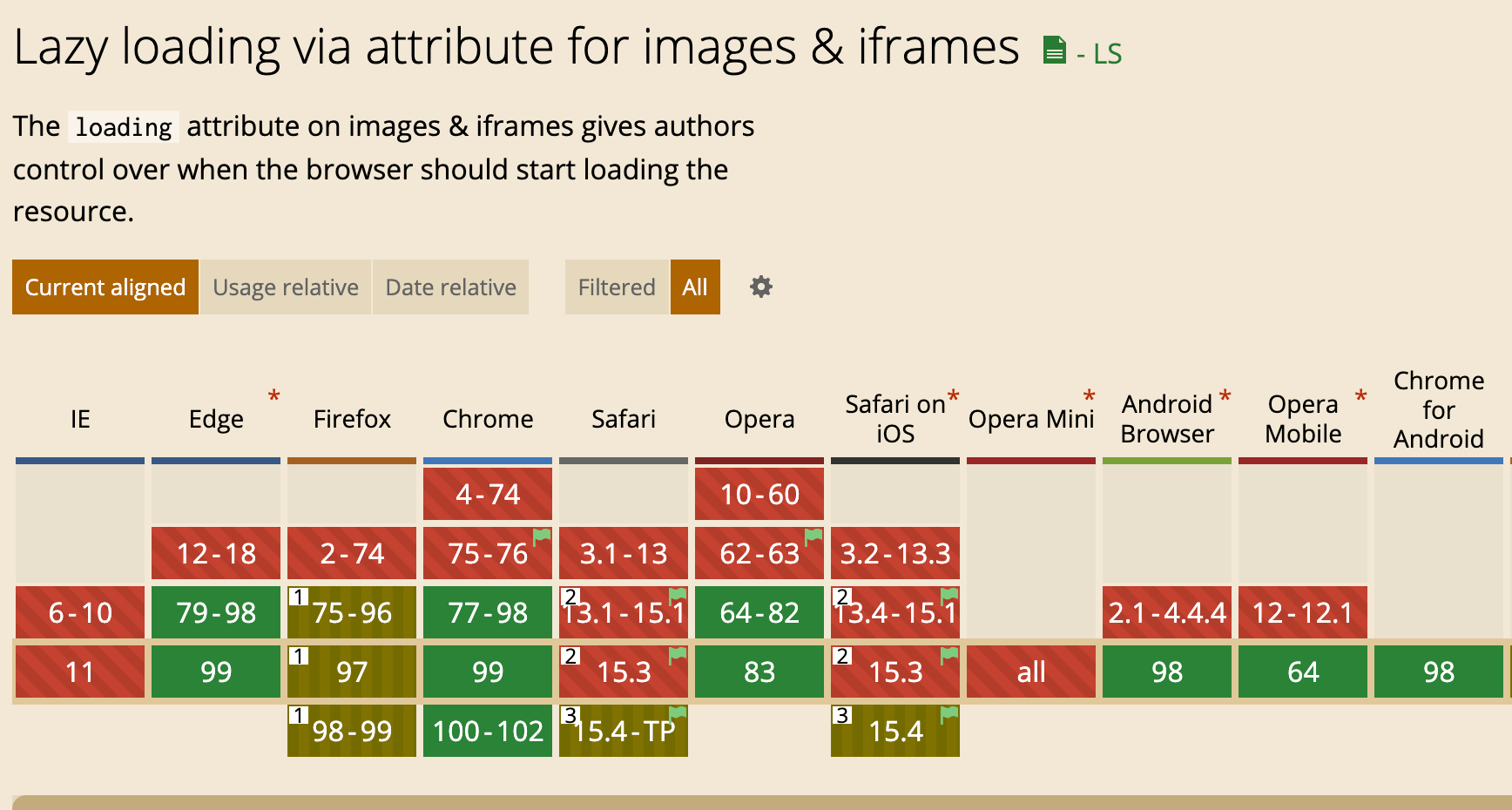懒加载是一种网页性能优化的方式,它能极大的提升用户体验。就比如说图片,图片一直是影响网页性能的主要元凶,现在一张图片超过几兆已经是很经常的事了。如果每次进入页面就请求所有的图片资源,那么可能等图片加载出来用户也早就走了。所以,我们需要懒加载,进入页面的时候,只请求可视区域的图片资源。
总结出来就两个点:
- 全部加载的话会影响用户体验
- 浪费用户的流量,有些用户并不想全部看完,全部加载会耗费大量流量。
实现方式
html 实现
最简单的实现方式是给 img 标签加上 loading="lazy",比如
<img src="./example.jpg" loading="lazy" />
该属性的兼容性也还行,大家生产环境可以使用。

js实现原理
我们通过js监听页面的滚动也能实现。
使用js实现的原理主要是判断当前图片是否到了可视区域:
- 拿到所有的图片 dom 。
- 遍历每个图片判断当前图片是否到了可视区范围内。
- 如果到了就设置图片的 src 属性。
- 绑定 window 的 scroll 事件,对其进行事件监听。
在页面初始化的时候,图片的src实际上是放在data-src属性上的,当元素处于可视范围内的时候,就把data-src赋值给src属性,完成图片加载。
// 在一开始加载的时候
<img data-src="http://xx.com/xx.png" src="" />
// 在进入可视范围内时
<img data-src="http://xx.com/xx.png" src="http://xx.com/xx.png" />
// 在一开始加载的时候
<div
data-src="http://xx.com/xx.png"
style="background-image: none;background-size: cover;"
></div>
// 在进入可视范围内时
<div
data-src="http://xx.com/xx.png"
style="background-image: url(http://xx.com/xx.png);background-size: cover;"
></div>
下面展示一个demo:
<html lang="en">
<head>
<meta charset="UTF-8" />
<title>Lazyload</title>
<style>
img {
display: block;
margin-bottom: 50px;
height: 200px;
width: 400px;
}
</style>
</head>
<body>
<img src="./img/default.png" data-src="./img/1.jpg" />
<img src="./img/default.png" data-src="./img/2.jpg" />
<img src="./img/default.png" data-src="./img/3.jpg" />
<img src="./img/default.png" data-src="./img/4.jpg" />
<img src="./img/default.png" data-src="./img/5.jpg" />
<img src="./img/default.png" data-src="./img/6.jpg" />
<img src="./img/default.png" data-src="./img/7.jpg" />
<img src="./img/default.png" data-src="./img/8.jpg" />
<img src="./img/default.png" data-src="./img/9.jpg" />
<img src="./img/default.png" data-src="./img/10.jpg" />
</body>
</html>
先获取所有图片的 dom,通过 window.innerHeight || document.documentElement.clientHeight|| document.body.clientHeight 获取可视区高度,再使用 element.getBoundingClientRect() API 直接得到元素相对浏览的 top 值, 遍历每个图片判断当前图片是否到了可视区范围内。代码如下:
function lazyload() {
let viewHeight =
window.innerHeight ||
document.documentElement.clientHeight ||
document.body.clientHeight; //获取可视区高度,兼容不同浏览器
let imgs = document.querySelectorAll("img[data-src]");
imgs.forEach((item, index) => {
if (item.dataset.src === "") return;
// 用于获得页面中某个元素的左,上,右和下分别相对浏览器视窗的位置
let rect = item.getBoundingClientRect();
if (rect.bottom >= 0 && rect.top < viewHeight) {
item.src = item.dataset.src;
item.removeAttribute("data-src");
}
});
}
最后给 window 绑定 onscroll 事件
window.addEventListener("scroll", lazyload);
主要就完成了一个图片懒加载的操作了。但是这样存在较大的性能问题,因为 scroll 事件会在很短的时间内触发很多次,严重影响页面性能,为了提高网页性能,我们需要一个节流函数来控制函数的多次触发,在一段时间内(如 200ms)只执行一次回调。
下面实现一个节流函数
function throttle(fn, delay) {
let timer;
let prevTime;
return function (...args) {
const currTime = Date.now();
const context = this;
if (!prevTime) prevTime = currTime;
clearTimeout(timer);
if (currTime - prevTime > delay) {
prevTime = currTime;
fn.apply(context, args);
clearTimeout(timer);
return;
}
timer = setTimeout(function () {
prevTime = Date.now();
timer = null;
fn.apply(context, args);
}, delay);
};
}
然后修改一下 srcoll 事件
window.addEventListener("scroll", throttle(lazyload, 200));
拓展: IntersectionObserver
通过上面例子的实现,我们要实现懒加载都需要去监听 scroll 事件,尽管我们可以通过函数节流的方式来阻止高频率的执行函数,但是我们还是需要去计算 scrollTop,offsetHeight 等属性,有没有简单的不需要计算这些属性的方式呢,答案就是 IntersectionObserver。
IntersectionObserver 是一个比较新的 API,可以自动”观察”元素是否可见,Chrome 51+ 已经支持。由于可见(visible)的本质是,目标元素与视口产生一个交叉区,所以这个 API 叫做”交叉观察器”。我们来看一下它的用法:
var io = new IntersectionObserver(callback, option);
// 开始观察
io.observe(document.getElementById("example"));
// 停止观察
io.unobserve(element);
// 关闭观察器
io.disconnect();
IntersectionObserver 是浏览器原生提供的构造函数,接受两个参数:callback 是可见性变化时的回调函数,option 是配置对象(该参数可选)。
目标元素的可见性变化时,就会调用观察器的回调函数 callback。callback 一般会触发两次。一次是目标元素刚刚进入视口(开始可见),另一次是完全离开视口(开始不可见)。
下面我们用 IntersectionObserver 实现图片懒加载
const imgs = document.querySelectorAll("img[data-src]");
const config = {
rootMargin: "0px",
threshold: 0,
};
let observer = new IntersectionObserver((entries, self) => {
entries.forEach((entry) => {
if (entry.isIntersecting) {
let img = entry.target;
let src = img.dataset.src;
if (src) {
img.src = src;
img.removeAttribute("data-src");
}
// 解除观察
self.unobserve(entry.target);
}
});
}, config);
imgs.forEach((image) => {
observer.observe(image);
});